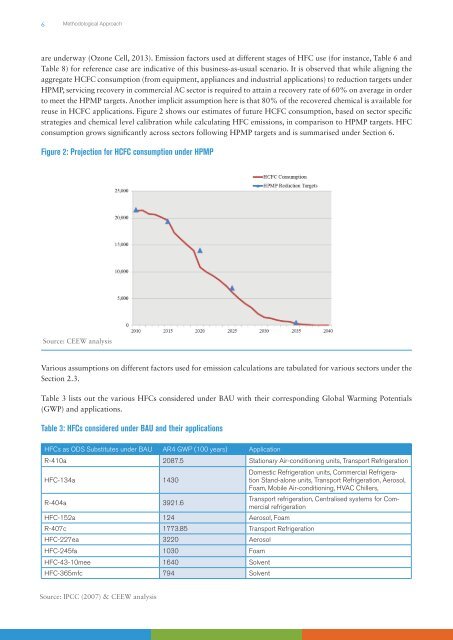Hydrofluorocarbon Emissions-Shakti Sustainable Energy Foundation
One such critically important category of gases is hydrofl uorocarbon (HFC). HFCs are potent greenhouse gases and are expected to contribute signifi cantly to global warming by 2050 (IPCC/TEAP, 2006; Velders et al., 2009; Gschrey et al., 2011; Miller & Kuijpers, 2011; Höglund-Isaksson et al., 2013). Read more information visit: http://shaktifoundation.in/report/indias-long-term-hydrofluorocarbon-hfc-emissions-detailed-cross-sectoral-analysis/
One such critically important category of gases is hydrofl uorocarbon (HFC). HFCs are potent greenhouse gases and are expected to contribute signifi cantly to global warming by 2050 (IPCC/TEAP, 2006; Velders et al., 2009; Gschrey et al., 2011; Miller & Kuijpers, 2011; Höglund-Isaksson et al., 2013). Read more information visit: http://shaktifoundation.in/report/indias-long-term-hydrofluorocarbon-hfc-emissions-detailed-cross-sectoral-analysis/
You also want an ePaper? Increase the reach of your titles
YUMPU automatically turns print PDFs into web optimized ePapers that Google loves.
6<br />
Methodological Approach<br />
are underway (Ozone Cell, 2013). Emission factors used at different stages of HFC use (for instance, Table 6 and<br />
Table 8) for reference case are indicative of this business-as-usual scenario. It is observed that while aligning the<br />
aggregate HCFC consumption (from equipment, appliances and industrial applications) to reduction targets under<br />
HPMP, servicing recovery in commercial AC sector is required to attain a recovery rate of 60% on average in order<br />
to meet the HPMP targets. Another implicit assumption here is that 80% of the recovered chemical is available for<br />
reuse in HCFC applications. Figure 2 shows our estimates of future HCFC consumption, based on sector specific<br />
strategies and chemical level calibration while calculating HFC emissions, in comparison to HPMP targets. HFC<br />
consumption grows significantly across sectors following HPMP targets and is summarised under Section 6.<br />
F igure 2: Projection for HCFC consumption under HPMP<br />
Source: CEEW analysis<br />
Various assumptions on different factors used for emission calculations are tabulated for various sectors under the<br />
Section 2.3.<br />
Table 3 lists out the various HFCs considered under BAU with their corresponding Global Warming Potentials<br />
(GWP) and applications.<br />
Table 3: HFCs considered under BAU and their applications<br />
HFCs as ODS Substitutes under BAU AR4 GWP (100 years) Application<br />
R-410a 2087.5 Stationary Air-conditioning units, Transport Refrigeration<br />
HFC-134a 1430<br />
Domestic Refrigeration units, Commercial Refrigeration<br />
Stand-alone units, Transport Refrigeration, Aerosol,<br />
Foam, Mobile Air-conditioning, HVAC Chillers,<br />
R-404a 3921.6<br />
Transport refrigeration, Centralised systems for Commercial<br />
refrigeration<br />
HFC-152a 124 Aerosol, Foam<br />
R-407c 1773.85 Transport Refrigeration<br />
HFC-227ea 3220 Aerosol<br />
HFC-245fa 1030 Foam<br />
HFC-43-10mee 1640 Solvent<br />
HFC-365mfc 794 Solvent<br />
Source: IPCC (2007) & CEEW analysis

















